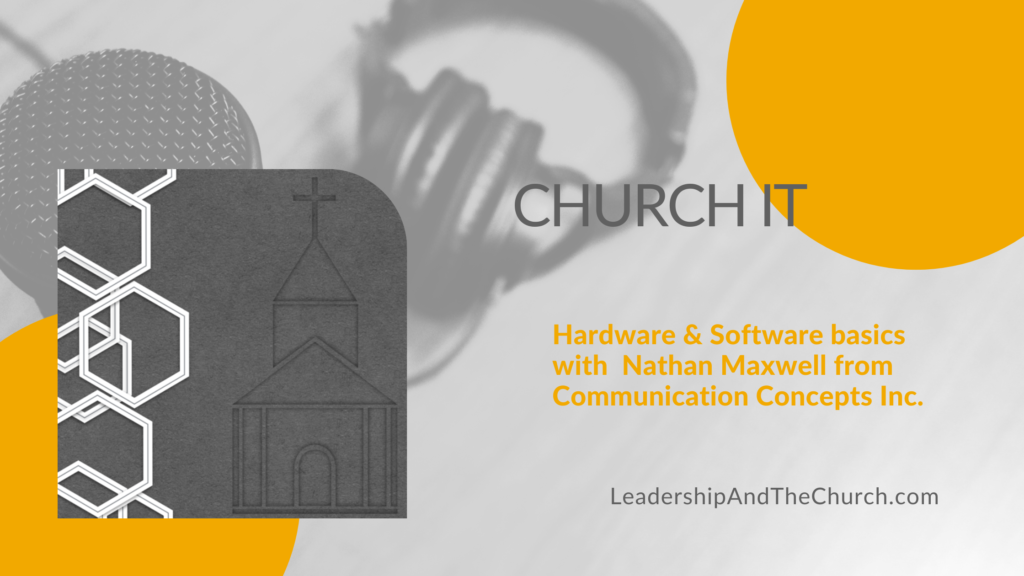Chris Miller, President of Miller Management, is the host of this week’s episode. He is joined by his colleague, Nathan Maxwell, Owner of Communication Concepts, Inc. (CCI).

This series is on Church IT, but our guest really likes to think of it as mitigating risk. From help desk to cyber security, their company does it all. Today’s topics will discuss IT planning and budgeting for software & hardware. Start at the beginning of the series here, or learn about security in this episode.
Master Plan
Having a five to six year master plan should be what drives the IT budget. Software, hardware, OpX, etc. Another planning strategy is buying cycles. This is where you have this software for X years and the year before the time is up, you start to reevaluate and make a decision for the next move forward.
Software
Look for non-profit discounts (like Adobe). So that you can have central management and oversight. Staff credit cards can be a good tool for that. Worship department will have cloud liscences. Office will have Adobe charges. But if you could pull them all together, you could reach out to the company to ask for a group discount.
Try not to let your worship team be on one software, and your youth pastor start a new one when he comes in. Corporate structure can be a good thing, people. Again, a little training can go a long way. Maybe the other software can do what you need, and you just didn’t realize that, yet.
The church needs insight into what they DONT own as well.
Microsoft 365/Google is another good example. When your new hire just brings in their personal email account and starts sharing all their documents left and right – everyone thinks it’s great. But what happens when that person moves on (which can be good thing, remember?) You don’t own all the things that your previous person was working on. The things they never did share with the team. You get to start over, instead of having a central server where things are stored. Or ownership over the email and you can retrieve anything you need later on.
A note about cost
The cost for liscenses, software, and storage is also something to take into consideration. If eveyone is doing their own things, you could be spending more money than if you were able to consolidate all the things together.
What’s your email?
Businesses usually do this real well. The business owns the software liscenses, and in turn all the emails. Plus, it does look more professional when emails are coming from a sanctioned email account. Not just someone’s obviously personal address. (We all had screen names we used in high school that we might be embarrssed about now, let’s keep those in the past, not in our emails.)
Hardware
Hardware: computers, monitors, & equipment. This goes back to having that five to six year plan in place. Rotate out those ipad, computers, etc. every five years. Then start looking at your server and network in year 5 to 7 – depending on use. Agressive stewardship is admirable as a church, but your TCO (total cost of ownership) shouldn’t be too low either – buy reasonable equipment. Your people deserve to have their equipment work.
An note on donations
Try to have as little as possible. We understand that you may still be in that penny pinching mindset. Or you don’t want to hurt the donors feelings, but don’t be afraid to say “that’s not a fit for our current staffing.” Our guest suggests having a list of items you would like to purchase and be able to share that in some capacity, for the generous donors.
How long should you keep devices?
Phones, tablets, computers, etc. should be evaluated by the device’s active support. After you are out from under that support, you are at risk of losing data, or it being stolen. For example, Server 2012 is no longer under active service, so if you have one of those at your organization, it is time to move on. Again, this is where planning comes into place. You need a plan in place BEFORE something old dies on you. For personal computers, 5 years is generally a good mark.
Refurbished equipment from known brands, like Dell and Apple, our guest has no issues with those. Still not cheap, but nothing is wrong with those. The grey area begins when you are looking at products that are already owned for 2-4 years. If the thought is to replace in a few years, maybe that is the most cost effective option for your organization. But just watch out for red flags, and tread carefully with pre-owned equipment.
Upload and Download Speeds
This is something you do want to take into consideration. Your download speed is probably what you are most often using for your internet activity during the week. The upload speed would be for Sunday morning live-streaming services. You will also need to take into consideration your dedicated bandwith for those services.
Your quality of service on your firewall and your guest wi-fi can come into play here as well. But that doesn’t help you with the nighborhood utilzing bandwidth at your peak times. Our guest encourages you to look into the numbers for your current service and if you are having problems with your internet, consider upgrading those upload and download numbers for better service.
In Conclusion
Testing, oversight, and dedicated IT resources and plans are critical to your church’s IT budget. Whatever plan you create now, will need to be updated each year.
Join us next week as Chris & Nathan wrap up their discussion on Church IT.
Join the conversation, see behind the scenes, and learn more on our Instagram and Twitter.
Special thanks to our guest, Nathan Maxwell, and our masters of all things Podcasting, Chris and Lauren Miller, for this third episode in our Church IT series.
